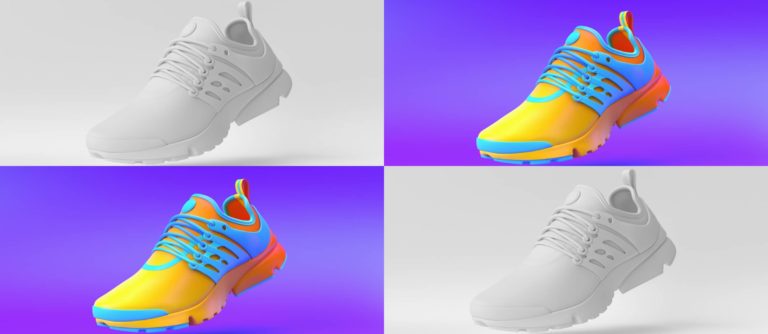
Augmented reality is becoming increasingly popular. From nearly 800 million mobile AR users last year to a projected 1.67 billion by 2025 according to ARtillery Intelligence, we’ve seen massive and continued uptake of this cutting-edge technology.
Much of this growth is a result of necessity: the effects of the pandemic plus the global shift to online shopping have resulted in thousands of stores closing. For brands that survived this tumultuous time, it became painstakingly obvious that innovation is key to staying relevant. As a result, more companies started to invest in AR technology, inspired, no doubt, by tech giants pushing heavily in this space, and the more this landscape develops, the more AR trends there are to keep track of.
Here are five that we’re tracking…
Mobile AR Users Approach 800 Million
1. AR NFTs and the metaverse
Although industry analysts and execs have been predicting the coming of the metaverse for years now, it wasn’t until October of 2021 — when Facebook rebranded itself as “Meta” — that the term reached full popular consciousness. Facebook’s decision to pour billions of dollars into virtual and augmented reality has made it clear to everyone, not just tech geeks, that the metaverse is the “next big thing.”
For anyone who may be unfamiliar with the term or needs a refresher: the metaverse is a shared digital environment that is layered over the real world. The idea is that one day, through metaverse-friendly devices like mobile apps and smart glasses, we will be able to inhabit virtual spaces in the form of an avatar that looks just like us, or show up as a hologram in our friend’s living room (or at the office, or a café).
Non-fungible tokens (or NFTs for short) will play an essential part in the metaverse, both in terms of how we can access it and perhaps more importantly what we can own there.
As digital one-of-a-kind assets, NFTs signify ownership of unique items, which can be anything from digital artwork and limited-edition sneakers to essays or in-game items. Some NFTs incorporate elements of augmented reality, creating an immersive experience for the user. (For example, by allowing them to see a digital object in their environment or on their body.)
Last year, we saw a lot of brands experimenting with NFTs. For example, the founder of Atari, Nolan Bushnell, released NFT arcade cabinets that users could view in 3D in their own homes. Similarly, the American heritage and sportswear brand Original Penguin auctioned off eight NFT penguin avatars that users could visualize in AR before purchasing them.
Also last year, the luxury fashion house Dolce & Gabbana released “Collezione Genesi,” an AR wearables NFT collection that netted the brand almost $6 million. While some items in the collection were physical (but came with a virtual counterpart), others, like “The Impossible Tiara,” existed solely in the digital space.
Meanwhile, the insurance company group State Farm launched a virtual treasure hunt where users could find 500,000 footballs using their phones and exchange them for NFTs, gift cards and autographed merchandise. Once a user found a football in a game, it was no longer visible to other players, and all players who completed the first level of the game received an NFT plus a chance to win other limited-edition examples.
If last year’s level of activity in these spaces is anything to go by, then in 2022, as the metaverse comes even closer to reality, we can expect more and more brands to launch NFTs.
The Virtual and IRL Verses of the Metaverse
2. AR live stream shopping
Already big in China, live stream shopping is now taking the Western world by storm.
Described by Sprout Social as “a cross between a video stream, variety show and group chat,” it is being increasingly used by brands to promote and sell products via ecommerce apps and social media platforms like Amazon Live or Instagram Live.
These shoppable live streams are typically led by influencers who demonstrate and describe a product. The audience can ask them questions as well as interact with one another (for example, ask each other’s opinions) in real time. For brands, hosting shoppable live streams comes with a number of benefits, including the ability to forgo (or at least decrease their reliance on) physical stores and speed up the selling process.
One big disadvantage, however, is that unlike visiting a physical store, watching someone showcase products on the Internet does not provide customers with an opportunity to try on items. Augmented reality live stream shopping could change that. On YouTube, creators can already enable “Beauty Try-On” — an AR ad format that allows viewers to try on beauty products virtually through a split screen while watching makeup tutorials and reviews.
Extending this capability to live streams is a natural next step, and one that we are likely to see happening in 2022, especially considering that 80% of marketers now recognize the potential of video streaming, according to the advertising services and software company Mediaocean.
How is Camera Commerce Producing Results Today?
3. AR in self-serve ecommerce platforms
It’s not just big brands that are investing in 3D/AR technology. Nowadays, even individual merchants and small businesses on self-service ecommerce platforms like Shopify can create augmented reality product previews. While Shopify introduced its AR feature back in 2018, the ecommerce platform has recently started pushing harder into AR integration.
By highlighting brands that already (successfully) use it and publishing reports and research that showcase the power of AR in ecommerce, Shopify has made this once obscure (and expensive) technology universal.
Through its marketplace of 3D modelling partners, a 3D Warehouse App for storing 3D models and a simple way of adding AR Quick Look support to its merchants’ stores, Shopify makes AR accessible to businesses even with the leanest budgets. Other platforms that also currently offer AR features to merchants include Magento, BigCommerce, WooCommerce and Etsy.
AR and Shopping Collide, Part III: Shopify
4. “Phygital” retail experiences expand
According to a 2021 study by IBM, 73% of people who used to frequent shopping centers are eager to return to physical stores. Although this may seem like an encouraging statistic to offline retailers, there is some bad news, too, namely:
- About 1 in 4 shoppers in the U.S. and the UK don’t feel safe shopping in-store.
- Around 40% of U.S. adults say they enjoy in-store shopping much less now than before the pandemic (15% reporting that their enjoyment has decreased at least a little).
- Just over 4 in 10 millennials don’t anticipate needing to return to in-store shops after the pandemic ends.
As online sales continue to grow, retailers will have no choice but to rethink the in-store experience if they are to entice customers back, and consumers are already showing a strong preference for shops that provide novel in-store experiences.
For example, a study by Snapchat found that about a fifth of consumers would go out of their way to visit a store with smart mirrors (or “magic mirrors”) and interactive screens that showed them how particular makeup, hair color or an outfit looked on them. Younger customers are even more enticed by digital technology in physical spaces: about a third of Generation Z customers would go out of their way to visit a store equipped with smart mirrors.
Smart mirrors and digital screens are a great example of “phygical” retail experiences (i.e., blended customer experiences that consist of both physical and digital). One unforeseen side-effect of the pandemic has been customer reluctance to try on items in-store. As brands look for ways to make people feel safe, we predict that smart mirrors will become ever more critical.
Going forward, brands will increasingly avail themselves of other AR and 3D technologies that help facilitate this new type of experience. For instance, in the near future, they may also use virtual avatars (witness Ralph Lauren’s Snapchat Bitmojis) to let customers “try on” its product catalogue in-store or at home.
6 Touchless Shopping Techs for IRL Retail
5. More brands embrace 3D search results on Google
Retailers adding 3D and AR experiences to product pages isn’t anything new: From IKEA to Warby Parker to Sephora, we’ve seen many do so already, and with great success. In fact, research by Shopify has shown that products with AR content see a 94% higher conversion rate than products that don’t have such elements.
However, while this tactic is certainly worth pursuing, it’s vital to note that not all customers will go directly to a retailer’s online store. Google’s own research revealed that half of shoppers Google search a product to learn about it in other ways before they commit to buying.
But what if, when a potential customer searched for your product on Google, the results page showed them a 3D version that they could view in AR in their homes with a click of a button? Rather than having to do extensive research on an item, they could simply “place” it in their own environment to take a better look and decide if it would work.
Google released this capability back in 2019, yet, apart from the fashion house Burberry, the watch brand Jaeger-LeCoultre and more recently the department store retail chain Kohl’s, remarkably few brands have taken advantage of it so far.
We anticipate that in 2022 and beyond, companies will rush to avail of 3D search results to better accommodate customers who have gotten used to shopping online.
What’s Google’s AR Incubation Play?
Staying on top of trends
Over the past year, brands and users started to pay real attention to AR and the possibilities that it could bring. With more companies investing in this technology than ever before, and a growing number of users aware of AR beyond just filters, keeping abreast of the changing landscape and current trends in that sector is now a must for anyone looking to prepare and secure their business for the future.
 David Ripert is CEO and co-founder of 3D and AR marketing platform Poplar Studio.
David Ripert is CEO and co-founder of 3D and AR marketing platform Poplar Studio.






